Swimfeeders, or feeders as they’re more commonly known these days, come in several different forms and everyone seems to have their own ideas on how to improve on a previous design in order to give them an edge over their fellow anglers.
Basically, they fall into three distinct versions, the closed or block end feeder, the open end feeder, and more recently, the method feeder.
Let’s deal with them in that order.
Block End (Maggot) Feeder
These were invented to hold maggots and are often referred to as a maggot feeder. I can remember using designs of these back in the 60s, but like all items of tackle, you can bet that someone designed the original back in Victorian days.
They have a lid incorporated in the design and usually have a fixed bottom end to stop the bait from freely flowing out. Around the sides are a number of holes through which the maggots can wriggle out and on some versions, the size of the holes can be varied to reduce the number of escapes thereby making the free food less available and lasting longer.
However, in recent years this type of feeder has been used to hold seeds like hempseed and bird seed, pigeon conditioner being a good one in point. Even small pellets are now used in some feeders for barbel and chub, but any bait type can be used so long as it doesn’t clog up in the holes.
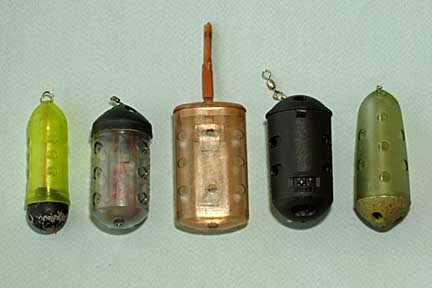
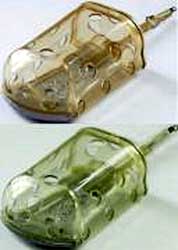
Look at the picture above and from left to right we have: A Thamesly feeder, sadly no longer made since the company ceased trading, but this was a good design. Next to it the ever popular Kamasan Black Cap feeder, push off the black cap and fill (see headline picture also). In the middle there’s the Drennan block end feeder, popular with the big fish boys as they do them in really big sizes that suit seed baits, sweetcorn even.
Fourth in is an adjustable feeder, I cannot remember who makes it, but I have a few and the sizes of the holes can be widened and closed to suit. Last of all is the latest Drennan Feeder Bomb, which I think is the best design so far. They’re easy to fill, with one hand almost, and enter the water with the minimum of noise. Lastly, on the far right, is the new Drennan Oval feeder that also comes in an in-line version too and is now very popular with the barbel anglers.
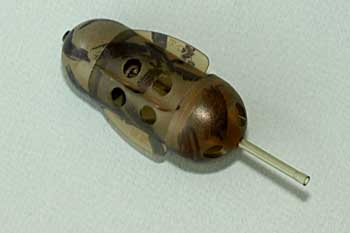 Variations on the closed end feeder are the in-line feeder, this one made by Fox. They work in exactly the same way except that your mainline goes through the feeder and that can be important in some conditions. This one also has fins to keep it straight when casting.
Variations on the closed end feeder are the in-line feeder, this one made by Fox. They work in exactly the same way except that your mainline goes through the feeder and that can be important in some conditions. This one also has fins to keep it straight when casting.
Adaptations you can make. Firstly you can take a permanent marker and scribble lines across the feeder to help disguise it. Any random pattern will do just to break up the straight lines that the fish might see and then spook it. Also, you can cut slots between the manufactured holes to allow more bait out, but once done, you can’t undo it less you wrap electrical tape around it.
Open End (Groundbait) Feeder
These are a little more recent in their concept, but have been around for many years now. Before they were manufactured, many match anglers used women’s hair curlers with lead strips wrapped around them and from this the idea of the open end feeder was born. They are used to carry groundbait and as such are sometimes referred to as groundbait feeders.
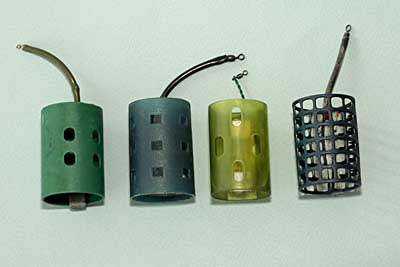
In the picture we have from left to right, a couple first made by Garcia. One with round holes and one with square holes, not that it makes one jot of difference. Then we have the favourite of them all, the Drennan Green feeder and this is the one favoured by many matchmen. The last is an adaptation using mesh for the walls of the feeder and some are made from plastic mesh (as pictured), whilst others from wire mesh. 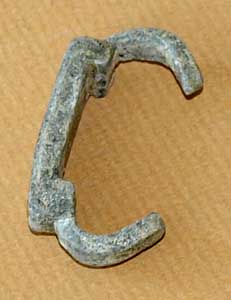 There are some variations now that have a tube fitted so that, like the in-line closed end feeder, they can be fished in-line, but many anglers regard these as no more than a gimmick.
There are some variations now that have a tube fitted so that, like the in-line closed end feeder, they can be fished in-line, but many anglers regard these as no more than a gimmick.
Adaptations you can make are to make them heavier by fitting weighted clips, sometimes known as “dead cows”, but they don’t fit all makes of feeder. The other change you can make, and very few anglers do this, is to lighten them by removing the side weight and drilling holes in it. By using both of these means you can balance a feeder according to river conditions say or shy biting fish.
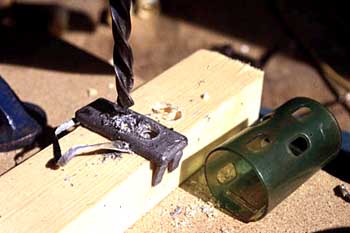 Also, with most of my feeders I slip a short length of silicone tubing over the connectors to reduce the chances of a tangle. You need tubing just wide enough to fit over the swivel and pull it through using some much stronger line, wetting it with a little spittle first helps. It just makes a neater job of the connection too.
Also, with most of my feeders I slip a short length of silicone tubing over the connectors to reduce the chances of a tangle. You need tubing just wide enough to fit over the swivel and pull it through using some much stronger line, wetting it with a little spittle first helps. It just makes a neater job of the connection too.
Method Feeders
These were introduced as late as the 1990s and they are used in-line normally and have the groundbait moulded around them with the hookbait tucked inside. The idea being that greedy fish, such as carp, attack the groundbait ball, find the hookbait and have it away. They do work too and it is a popular method used on many waters.
A weight is incorporated in the shape, but the more clever designs have it so that the feeder always lands with the weight at the bottom. This means that if you place your hook bait opposite the weight, you know it will be uppermost when the fish tear apart the groundbait. It all adds to the level of confidence you have.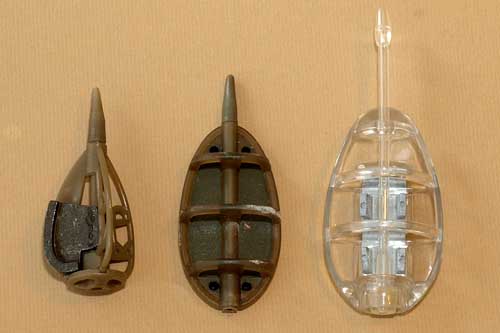
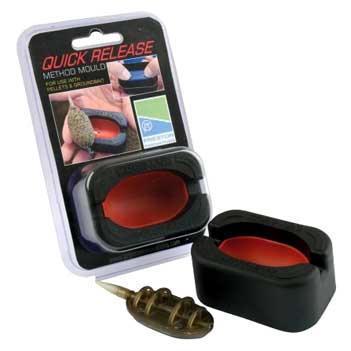
Pictured we have (L to R) the Korda feeder with the weight on one of the three fins and one of the first to do this. Next there is the Fox flat bottomed feeder, but it has been known for these to land upside down, not very often though. Lastly is one that I like very much, the Korum In-line feeder, but beware, there is another similar Korum model that utilises a length of pole elastic and some fisheries would view this as a “fixed rig” and ban it.
Korum also have a flat feeder design out and to go with it, a feeder mould in which you can create the perfect feed ball (on far right of pictures).
That would be about it, but for …..
New Designs
There’s always someone coming up with a new idea, often a slant on the existing design, but one company that has been rather innovative in recent years is Dinsmores, famed for their range of split shot.
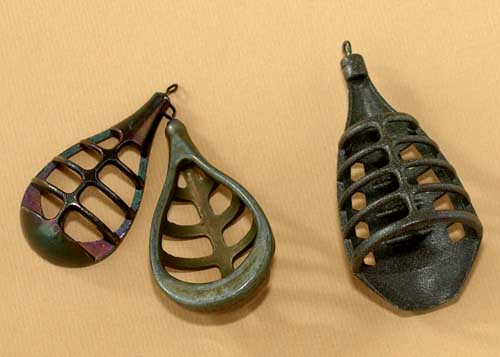
They came up with two different designs. On the left there is the Feeder Bomb, a spoon shaped device cast in solid metal and almost unbreakable, or at least I’ve not heard of one breaking yet. I found this useful to pack with liquidised bread for chub fishing, but you can pack it with stiff groundbait and even the Cats & Dogs pellets. On the right is the very latest Scoop Feeder intended for use with any dampened pellets, but can also be used with any groundbait.
And for something really different from Middy, watch this on the Shotgun Feeder –
In conclusion, things have come a long way since the old days of just using a plummet, coffin or barrel lead, or bomb. These will still have their uses, but much more in favour these days are feeders simply because they introduce an attractant as well as providing the weight to cast and hold the bait out there.
NB: We will endevour to update the article periodically as any new types of feeder come onto the market.
All You Need to Know About – Quiver/Feeder Rods










